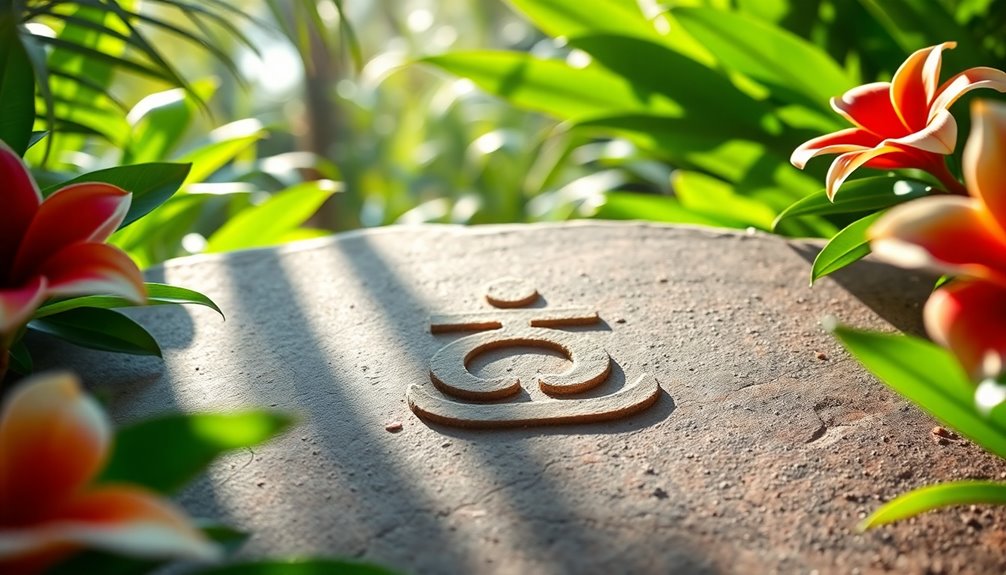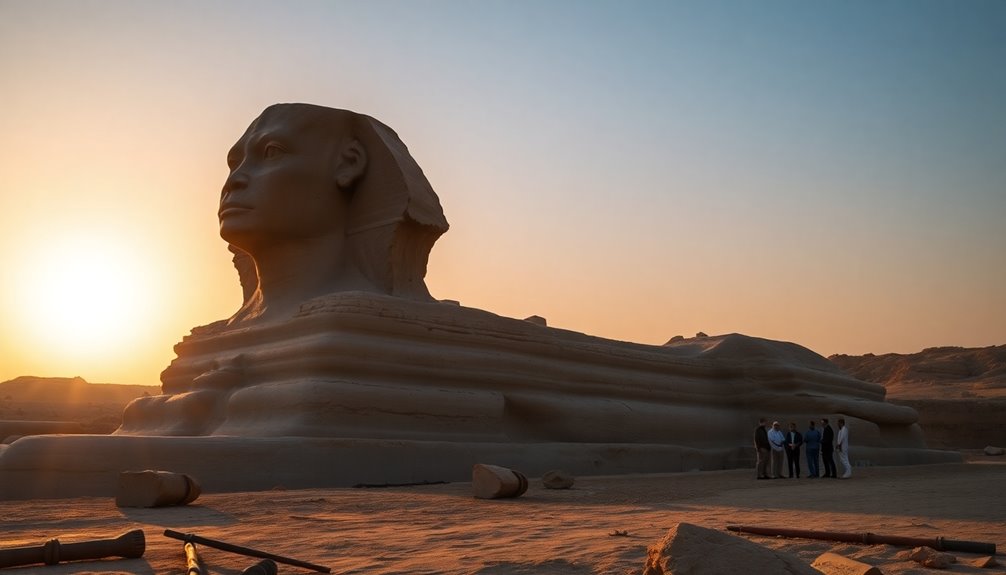The Namaste symbol isn't just a trendy phrase; it embodies deep cultural and spiritual meanings. Translating to "I bow to you," it reflects respect and acknowledgment of the divine in everyone. You often see it in yoga practices, but many miss its true significance, reducing it to a casual greeting. Its widespread use shows a global yearning for unity and mindfulness. Yet, there's a risk of losing its rich heritage through commercialization. Understanding its roots can enhance your daily interactions and connections. Want to explore how to embrace Namaste authentically in your life? You'll find more insights ahead.
Key Takeaways
- "Namaste" symbolizes respect and acknowledges the divine in others, making it a powerful gesture for fostering unity and connection.
- Its global popularity stems from the wellness community's desire for mindfulness and spiritual connection, transcending cultural boundaries.
- The commercialization of "Namaste" has led to a superficial understanding, often detaching it from its rich cultural and spiritual roots.
- Misinterpretations arise when "Namaste" is used casually in Western contexts, neglecting its deeper meanings and significance in South Asian cultures.
- Embracing "Namaste" in daily life promotes authentic connections and enhances mental well-being, enriching interpersonal relationships and community bonds.
Its Not What You Think
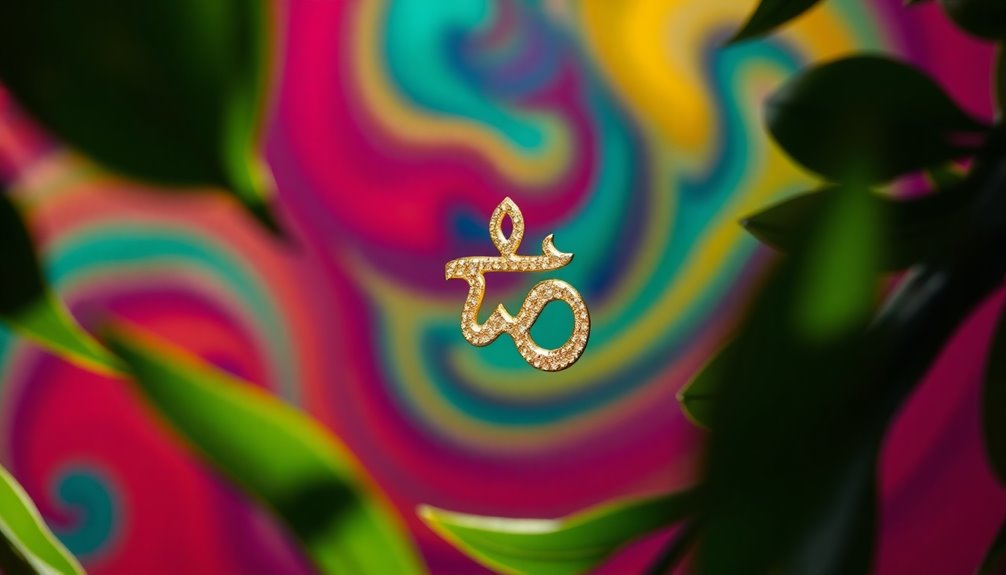
When you hear the word "Namaste," you might picture a serene yoga class or a peaceful spiritual retreat, but it's not just a trendy phrase. The term carries deep cultural significance, especially in South Asian contexts. It's a respectful greeting, accompanied by the Anjali Mudra gesture—hands pressed together at chest level, symbolizing respect and acknowledgment.
However, in Western yoga studios, "Namaste" has become somewhat commercialized. You may notice it frequently used by instructors and participants who mightn't fully grasp its meaning or cultural weight. This can lead to a disconnect, as some South Asians perceive its casual use as cringy, stripping away the depth and reverence it holds in its original setting.
While you're enjoying the practice, it's important to recognize that "Namaste" represents more than just a goodbye or a way to end a session.
Its adoption in the West has sparked new interactions with Eastern symbols, but often, these lack the richness of their traditional significance. Understanding this can enhance your experience and foster a deeper appreciation for the culture behind the phrase.
What Does Namaste Mean?
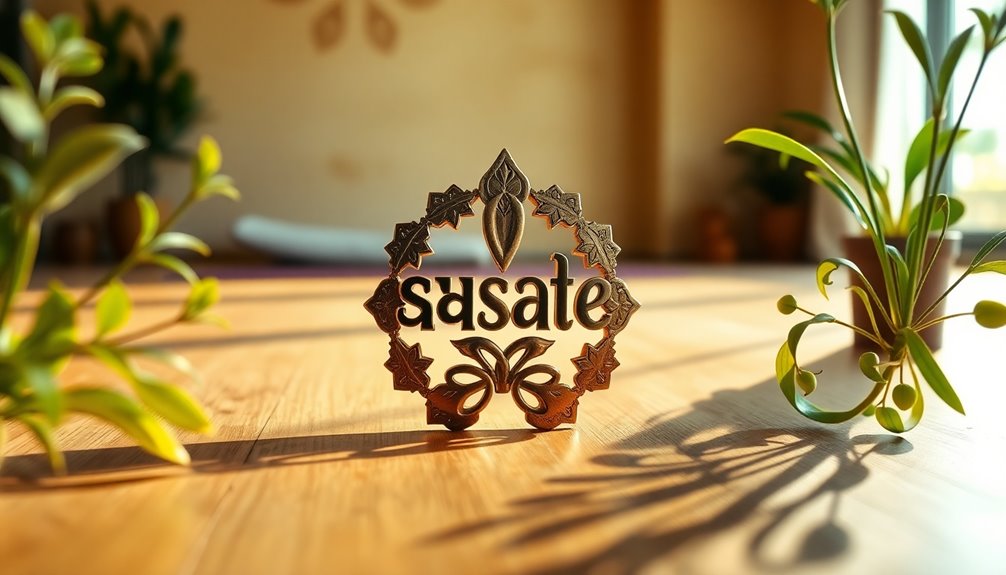
At its core, "Namaste" means "I bow to you," with roots in Sanskrit that highlight respect and acknowledgment. This greeting originates from two words: "namah," meaning to bow, and "te," meaning you. While it's a common salutation, its spiritual significance goes deeper. When you say "namaste," you recognize a connection to all of creation, symbolizing shared divinity and promoting unity.
Here's a quick breakdown of what "Namaste" embodies:
| Aspect | Meaning |
|---|---|
| Translation | "I bow to you" |
| Cultural Use | A respectful greeting |
| Ego Negation | "Namaha" signifies "not mine" |
| Spiritual Impact | Encourages humility and connection |
While it's often used in Western yoga classes, many South Asians find the overuse cringy, as it can feel disconnected from its cultural roots. Understanding "namaste" enriches your interactions, allowing you to appreciate its true essence and the humility it encourages in every greeting.
Spiritual Interpretations of Namaste
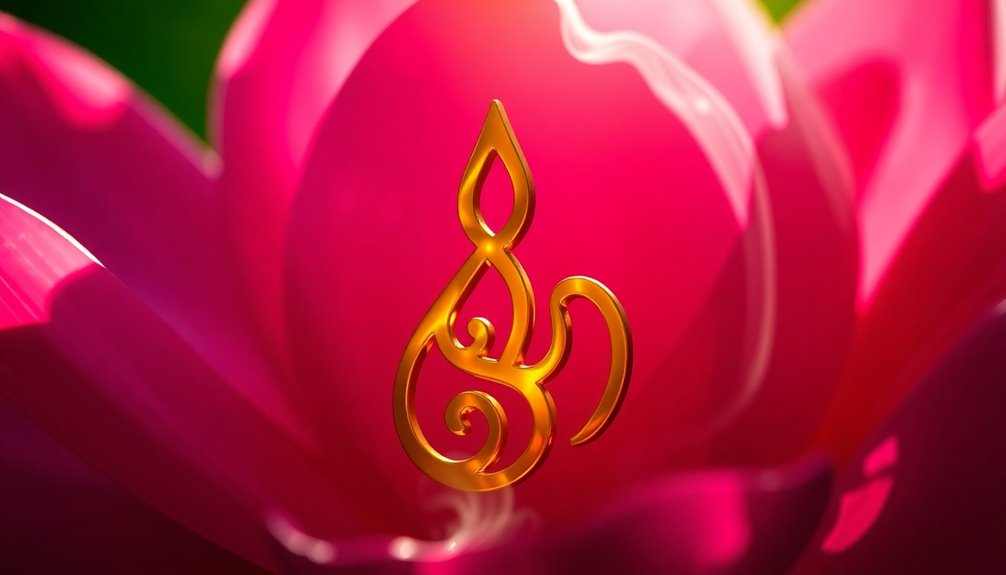
While many people use "Namaste" as a simple greeting, its spiritual interpretations reveal a profound connection to the divine within each individual. The term translates to "I bow to you" in Sanskrit, emphasizing respect and acknowledging the presence of the divine in others. This greeting carries deep spiritual significance; it symbolizes the recognition of shared divinity and interconnectedness among all beings.
When you greet someone with Namaste, you tap into an ancient belief in the cosmic divinity that exists within everyone, fostering unity and respect. The related term "Namaha," meaning "not mine," highlights the importance of ego negation and humility in your interactions. By embodying these principles, you cultivate a deeper understanding of yourself and others.
In yoga and meditation settings, using Namaste encourages a heightened spiritual connection and awareness of the peace that resides within. It invites you to reflect on your inner divinity and that of those around you.
Ultimately, embracing the spiritual significance of Namaste enriches your relationships and enhances your journey toward self-discovery and enlightenment.
Correct Pronunciation of Namaste
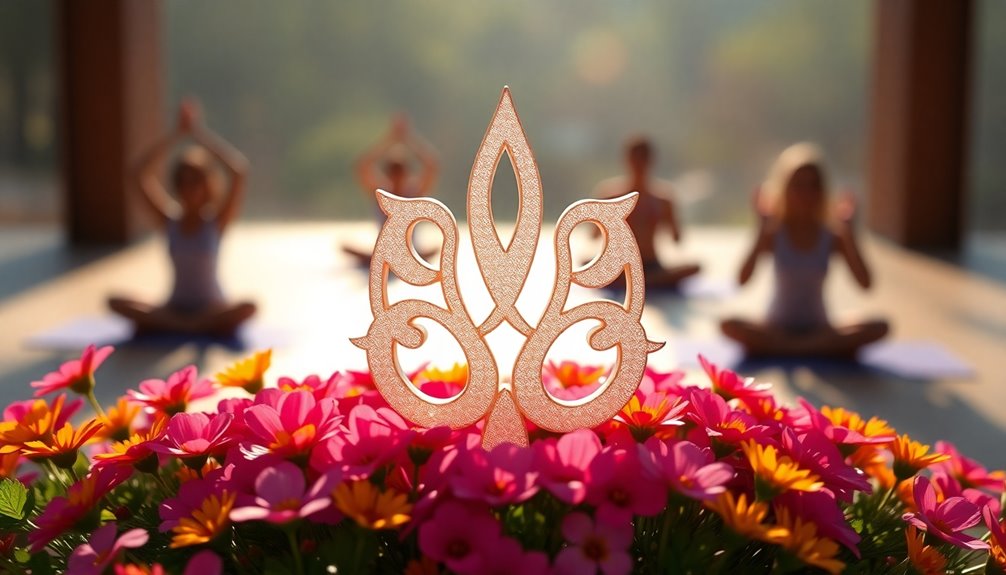
When you say "namaste," it's important to get the pronunciation right.
Many people mistakenly pronounce it as nah-mah-STAY, but the correct way is nuh-MUH-steh, with the emphasis on the second syllable.
Accurate pronunciation not only honors the word's roots but also reflects your respect for its cultural significance.
Common Mispronunciations Explained
Many people often mispronounce "namaste," leading to confusion about its true essence. The common mispronunciation you may hear in the West is "nah-mah-STAY." However, this differs markedly from the correct pronunciation: "nuh-MUH-steh." Here, the emphasis is placed on the second syllable, which aligns with Sanskrit grammar rules.
When you pronounce "namaste," keep in mind that the vowel "a" resembles a short "u," similar to the sound in the word "sun." This nuance is essential for capturing the authentic sound. Additionally, the "e" at the end has a subtle "eh" sound, contrasting with how it's typically pronounced in English.
Understanding the correct pronunciation can deepen your connection to this beautiful word, which embodies respect and acknowledgment.
It's also interesting to note that the "om sound" often associated with meditation and spirituality plays an important role in the context of "namaste." Just as the word Om holds a profound meaning in many cultures, so does "namaste." By pronouncing it correctly, you honor its rich heritage and the intentions behind it.
Importance of Accurate Pronunciation
Accurate pronunciation of "namaste" plays an essential role in conveying its true meaning and respect for its cultural origins. The correct way to say it is nuh-MUH-steh, with the emphasis on the second syllable. This differs from the common mispronunciation nah-mah-STAY often heard in the West.
Understanding how to pronounce this sacred word not only honors its roots but also enriches your interactions. The nuances in pronunciation, like the short "u" in "sun" and the subtle "eh" in the final "e," are crucial.
Here's a quick breakdown:
| Pronunciation Aspect | Correct Sound |
|---|---|
| First syllable | nuh |
| Second syllable | MUH (emphasis) |
| Third syllable | steh |
| Cultural Significance | Om, respect, unity |
Namaste Gesture
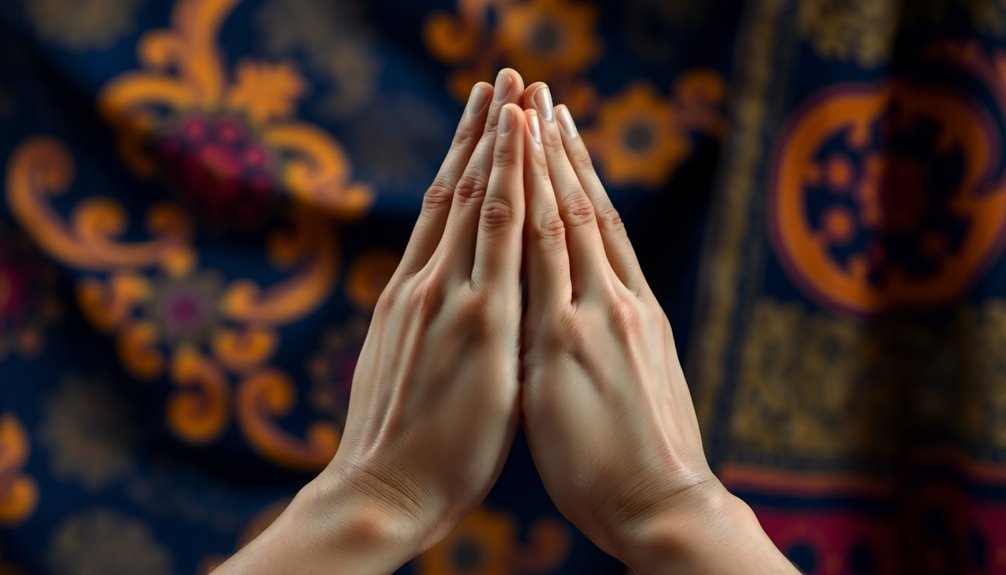
Have you ever noticed the profound simplicity of the Namaste gesture? Also known as Anjali Mudra, this gesture involves pressing your palms together at chest level, symbolizing respect and greeting between individuals. You can perform the Namaste gesture silently or verbally express it with the word "namaste," which adds a spiritual layer to your communication.
In Indian culture, it's common to use this gesture without saying anything, allowing for a non-verbal acknowledgment of another person's presence. This simple act serves as a recognition of shared divinity and interconnectedness among people, promoting a sense of unity.
In Western yoga and meditation practices, the Namaste gesture has gained popularity as part of the ritual at the beginning and end of classes. This practice reinforces a collective sense of community and mindfulness, reminding you that everyone in the room shares a connection.
Cultural Significance of Namaste
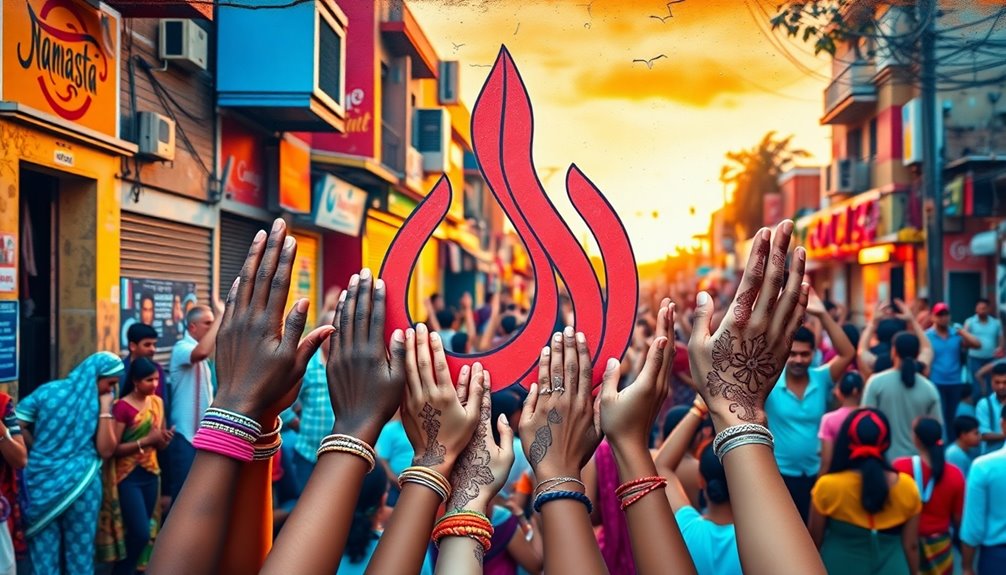
When you practice yoga, you might notice how the term "namaste" has crossed cultural boundaries, but it's crucial to understand its deeper significance.
Misinterpretations and instances of cultural appropriation often arise, leading to a disconnect between the gesture and its original meaning. Additionally, understanding the importance of ethical considerations in cultural practices can help foster respect and awareness of diverse traditions.
Global Yoga Practices Influence
In recent years, many people have embraced the practice of saying "Namaste" as part of their yoga experience, highlighting its cultural significance. This phrase, often vocalized at the end of yoga classes, fosters respect among participants and strengthens community ties.
It's a beautiful reminder of the shared journey in your practice. The gesture that accompanies "Namaste," Anjali Mudra, further connects you to Indian traditions and promotes mindfulness.
However, as its use expands, some South Asians view its overuse as cringeworthy, pointing out cultural misunderstandings surrounding its deeper meanings.
Here are several key influences of "Namaste" in global yoga practices:
- Eastern Spirituality: A growing interest in Eastern philosophies fuels the popularity of "Namaste" in yoga.
- Community Connection: Saying "Namaste" at the end of classes creates a sense of belonging among practitioners.
- Mindfulness Practice: Embracing this gesture encourages a mindful approach that resonates with yoga's core values.
Despite commercialization, "Namaste" retains its spiritual depth, emphasizing the recognition of the divine within each individual. This connection enriches your yoga experience, making every session meaningful.
Moreover, understanding the concept of emotional alignment can further enhance the practice by fostering deeper connections among participants.
Misinterpretation and Cultural Appropriation
The growing popularity of "Namaste" in yoga has sparked discussions about its misinterpretation and the potential for cultural appropriation. Many people in the West use "Namaste" without understanding its deeper significance, leading to a disconnect with its cultural roots.
| Aspect | Western Interpretation |
|---|---|
| Meaning | Just a casual greeting |
| Cultural Significance | A respectful acknowledgment of connection |
| Gesture (Anjali Mudra) | A simple hand gesture |
In Sanskrit, "Namaste" means "I bow to you," reflecting a gesture of respect. However, in many Western yoga classes, it's often vocalized without the accompanying understanding of its spiritual depth. This commercialization can feel cringeworthy to many South Asians, who see it as a form of cultural appropriation.
The gesture associated with "Namaste," Anjali Mudra, emphasizes recognition and unity, not merely a verbal salutation. By recognizing these nuances, you can honor the tradition rather than contribute to its misinterpretation. Engaging with "Namaste" respectfully helps bridge the cultural gap and fosters a more authentic connection to its origins.
Connection to Spirituality
Embracing the essence of "Namaste" connects you to a profound spiritual tradition that transcends mere greetings.
Originating from Sanskrit, "Namaste" means "I bow to you," and it emphasizes a deep spiritual connection and respect for the divine within each individual. In Hinduism, this greeting reflects the belief in shared divinity and interconnectedness among all beings.
The gesture accompanying Namaste, known as Anjali Mudra, involves pressing your palms together at your heart. This physical manifestation of respect enhances spiritual interactions, reminding you of the sacredness in every encounter.
Consider the cultural significance of Namaste:
- It acknowledges the divine presence in others, fostering a sense of unity.
- The practice enriches your yoga and meditation experience, inviting a mindful approach.
- Overuse in Western contexts challenges you to engage critically with Eastern symbols and their meanings.
Namaste in Yoga Practices

"Namaste" plays an important role in yoga practices, fostering a sense of connection among participants. You often hear this term vocalized at the beginning and end of yoga classes, serving as a respectful greeting that unites everyone in the space.
When you perform the Anjali Mudra gesture, pressing your hands together at your chest while saying "Namaste," it symbolizes a connection to yourself and those around you. This practice acknowledges the divine within each individual, aligning perfectly with the spiritual philosophy embraced in yoga.
However, the usage of "Namaste" in Western yoga studios has led to some cultural concerns. Many South Asians feel that its overuse can feel cringy, as it seems commercialized and detached from its roots.
It's important to maintain the cultural integrity of "Namaste" by paying attention to its pronunciation, "nuh-MUH-steh," especially in yoga settings. By doing so, you honor the term's significance and foster a deeper sense of respect within your practice.
Ultimately, using "Namaste" in yoga reinforces the community aspect of your journey, reminding you of the shared experience and connection among all participants.
The Global Spread of Namaste
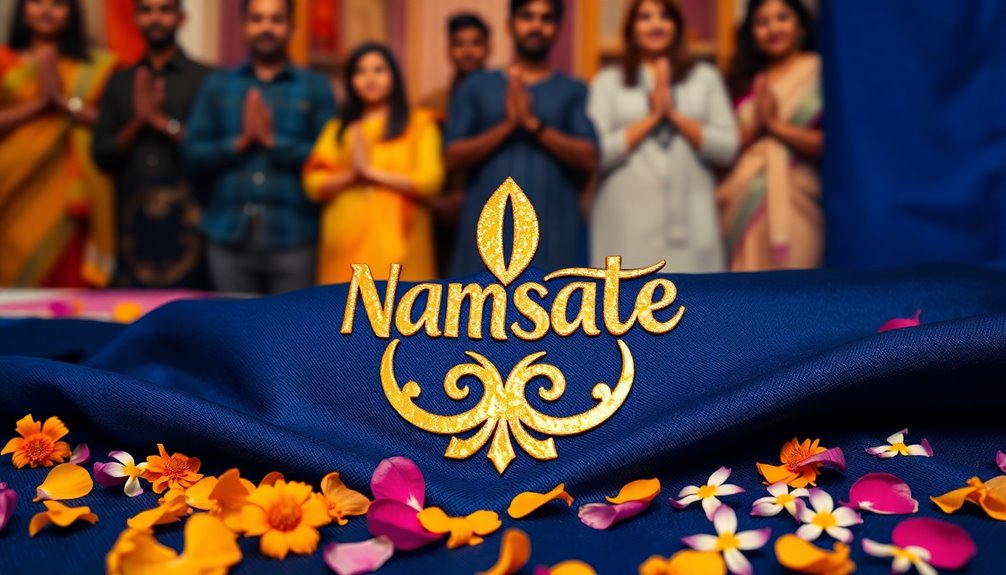
Witnessing the global spread of "Namaste" highlights its transformation from a traditional greeting to a widely recognized symbol of respect and connection.
You've probably noticed it popping up in various settings, especially in yoga studios and wellness communities. While its popularity signifies a desire for unity and interconnectedness, commercialization in Western culture has diluted its original meaning.
Here's how Namaste has evolved in modern times:
- Widespread Use: You've seen it used by individuals who may not fully grasp its cultural significance, often leading to misunderstandings. Listening to classical music can enhance the mindfulness of those practicing Namaste, deepening their appreciation of the moment. Additionally, the rising interest in essential oils has contributed to a holistic approach to well-being that complements the practice.
- Symbol of Unity: Despite its overuse, Namaste still resonates with those seeking deeper spiritual connections, acting as a reminder of our shared humanity.
- Cultural Adaptation: As interest in Eastern spirituality grows, Namaste appears in diverse contexts, from fashion to branding, showcasing its adaptability.
- The practice of nighttime meditation can enhance the spiritual aspect of Namaste, promoting relaxation and deeper connections to oneself and others.
Namaste and Mindfulness
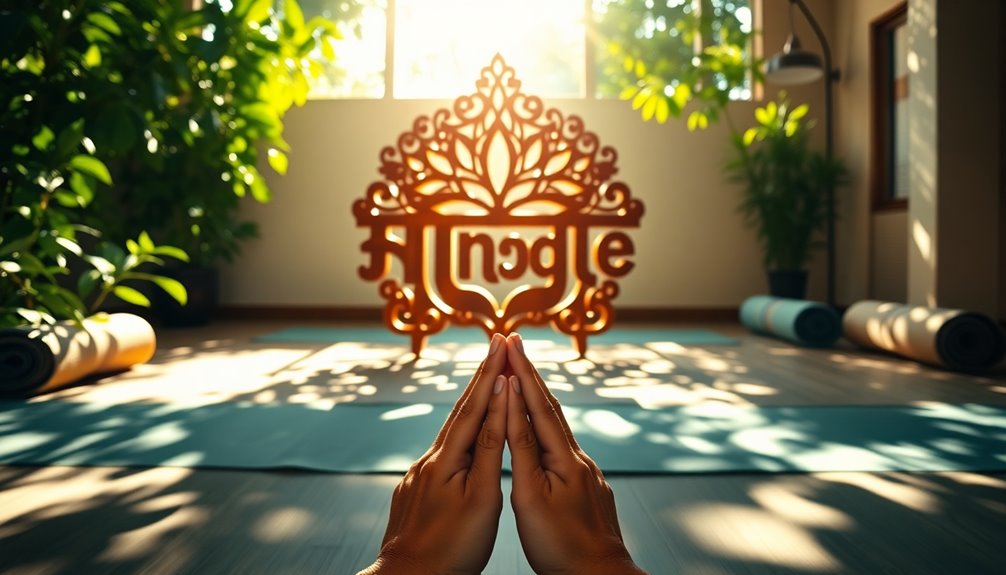
When you embrace the gesture of "Namaste," you invite mindfulness into your daily life. This simple act fosters a sense of unity and helps you cultivate present awareness, enriching your interactions. Additionally, practicing mindfulness can enhance your ability to develop a growth mindset, enabling you to navigate challenges with greater ease. Incorporating self-care practices into your routine can further support your mindfulness journey and overall well-being, as daily practices can strengthen your connection to the Vortex. Engaging in mindfulness techniques can help block internal chatter and external distractions, allowing for a more focused and peaceful experience. Furthermore, regular outings with your dog can promote socialization opportunities, enhancing both your and your pet's overall well-being.
Mindfulness in Daily Life
How can a simple gesture transform your daily interactions? Incorporating "Namaste" into your greetings can elevate your mindfulness practice and enhance the peace you experience in everyday life.
This gesture, known as Anjali Mudra, serves as a powerful reminder to acknowledge the divine connection within yourself and others. By using "Namaste," you foster genuine connections and diminish the superficiality of interactions. Additionally, engaging in activities that encourage social skills development can enhance the authenticity of these connections. Research suggests that practicing gratitude through daily interactions, such as saying "Namaste," can lead to improved mental well-being. Moreover, embracing secure attachment in your relationships can significantly deepen the bonds formed through such mindful greetings. In fact, laughter and humor among seniors can also enrich these interactions, promoting a lighter atmosphere.
Here are three ways to integrate mindfulness through "Namaste":
- Acknowledge Shared Humanity: When you greet others with "Namaste," you promote awareness of our collective existence, fostering authentic connections.
- Ground Yourself: Mindfully reciting "Namaste" can help center you amidst daily distractions, allowing you to reconnect with your inner peace.
- Embrace Humility: The meaning of "I bow to you" encourages you to release ego, an essential aspect of cultivating mindfulness. Additionally, participating in spiritual retreats can further enhance your mindfulness journey and provide deeper insights into your practice.
Unity Through Namaste
Integrating "Namaste" into your daily interactions not only enhances your mindfulness but also fosters a deeper sense of unity among people. When you say "Namaste," meaning "I bow to you," you recognize the divine within each person, promoting a profound interconnectedness that transcends surface-level exchanges. This respectful greeting encourages authentic connections, inviting you to engage more meaningfully with those around you.
Incorporating Namaste into your life reinforces the importance of shared humanity. In yoga and meditation, the gesture symbolizes an acknowledgment of another's soul, nurturing peace and unity. As you embrace this practice, you cultivate greater awareness of your interactions and relationships, which can lead to a collective sense of harmony. Additionally, the principles of astrological compatibility can enhance your understanding of how to connect with others on a deeper level.
The growing popularity of Namaste in Western culture reflects a broader interest in Eastern philosophies and mindfulness practices. By adopting this approach, you contribute to peaceful interactions that uplift not only yourself but also those in your community.
Ultimately, using Namaste as a daily reminder encourages you to foster unity, promoting a more compassionate and connected world.
Cultivating Present Awareness
Cultivating present awareness through the practice of "Namaste" considerably enhances your mindfulness in daily interactions. By acknowledging the divine in both yourself and others, you foster a deeper sense of connection that grounds you in the moment.
This practice not only enriches your relationships but also serves as a powerful reminder to remain present.
Incorporating the Namaste gesture—pressing your hands together at chest level—further enhances mindfulness by creating a physical symbol of respect and unity.
Here are some ways you can integrate Namaste into your life:
- Pause and Reflect: Take a moment to consciously say "Namaste" before engaging with others, allowing yourself to center your thoughts.
- Mindful Greetings: Use this gesture in daily interactions to cultivate deeper connections and show appreciation for those around you.
- Yoga and Meditation: Verbalizing "Namaste" at the end of your practice helps ground you, reinforcing your commitment to being present.
Bringing Namaste Into Daily Life

In daily life, incorporating the gesture of namaste can transform your interactions and foster deeper connections with those around you. By using namaste as a greeting, you acknowledge the divine essence in yourself and others, promoting a sense of respect and mindfulness. This simple act can shift your perspective, allowing you to approach each encounter with humility and interconnectedness. Supporting a partner in this practice can enhance the sense of community and connection that comes with embracing namaste.
You can practice namaste not only in yoga or meditation but also at home and in the workplace. This creates a harmonious atmosphere that reinforces shared values of respect and unity. When you greet someone with namaste, you're inviting a moment of reflection and compassion, enhancing the quality of your exchanges.
Consider integrating namaste into your daily routine. Acknowledge family members with a gentle namaste gesture before meals or use it as a peaceful way to start meetings at work. This small change can lead to a more compassionate mindset, helping you build deeper connections in all areas of your life. Additionally, practicing love and compassion can further deepen your relationships and enrich your interactions.
As you embrace the essence of namaste, you'll find that your relationships flourish, and a sense of community emerges, enriching your daily experiences.
Frequently Asked Questions
What Does the Namaste Symbol Mean?
The namaste symbol represents a deep respect and acknowledgment of the divine within others. When you use it, you're not just greeting someone; you're recognizing a shared spiritual connection.
In Sanskrit, it translates to "I bow to you," emphasizing humility and unity. While it's often popularized in Western cultures, you might find that its rich spiritual significance is sometimes overlooked, leading to a disconnect from its original meaning.
Embrace its true essence!
What Is the Hidden Meaning of Namaste?
When you say "namaste," you're not just greeting someone; you're acknowledging their spirit.
This simple gesture, hands pressed together, symbolizes unity and respect. The hidden meaning reveals a deeper connection, inviting you to recognize the divine in others.
As you bow your head slightly, it's a reminder to set aside your ego and embrace the shared essence of humanity.
In this moment, you cultivate a sense of oneness with everyone around you.
What Is the Meaning of Namaste 🙏?
The meaning of "namaste" goes beyond a simple greeting. When you say it, you're acknowledging the divine within the person you're addressing, recognizing a deep connection between you both.
It translates to "I bow to you," reflecting respect and unity. Often, it's accompanied by the Anjali Mudra gesture, where you press your hands together at your chest, symbolizing this acknowledgment.
Embracing its essence can enrich your interactions and promote harmony.
What Is the Namaste Prayer?
When you greet someone with Namaste, you're embracing a profound tradition.
The Namaste prayer, meaning "I bow to you," reflects respect and acknowledges the divine spark within others. Derived from Sanskrit, it's more than just words; it's a heartfelt gesture.
You press your palms together at your heart, symbolizing unity and connection. In that moment, you recognize the shared divinity in everyone, fostering a deep sense of interconnectedness and peace.
Conclusion
So, next time you see or hear "namaste," remember it's more than just a trendy phrase; it's a bridge connecting cultures and promoting mindfulness. By embracing the spirit of namaste, you invite peace and gratitude into your daily life, transforming ordinary moments into extraordinary experiences. Why not take a moment today to share a namaste with someone? After all, a simple gesture can spark a connection that brightens both your day and theirs.

